Inequality in Immunization 2023
A special issue of Vaccines (ISSN 2076-393X).
Deadline for manuscript submissions: closed (28 February 2023) | Viewed by 71783
Special Issue Editors
Interests: health inequality; monitoring; immunization
Special Issues, Collections and Topics in MDPI journals
Interests: immunization; vaccine delivery
Special Issues, Collections and Topics in MDPI journals
Interests: health systems; inequalities; social determinants of health
Special Issues, Collections and Topics in MDPI journals
Interests: immunization; vaccine delivery; life course
Interests: immunization; monitoring evaluation and learning
Special Issues, Collections and Topics in MDPI journals
Special Issue Information
Dear Colleagues,
While overall in the world, immunization rates stagnated prior to the COVID-19 pandemic, and declined in 2020 and 2021, this is neither uniformly the case for all types of vaccines, nor for all population sub-groups for any individual vaccine. Furthermore, the breadth of protection varies, with many countries lagging behind in the introduction of new and under-utilized vaccines, such as those against the Human Papilloma Virus (HPV) and seasonal influenza, to name a few. In this Special Issue, we will explore the latest evidence on various types of immunization across the life course at global, regional, national and subnational levels. We encourage submissions that explore various dimensions of inequality—such as economic status, subnational geographic regions, sex, maternal education—and other categories (like migrant status or occupation), or that shed greater analytical or methodological light on priority population subgroups, namely, populations facing gender barriers, rural residents, the urban poor, and populations living in conflict areas. We encourage submissions that compare various country contexts or that assess trends over time, and those that draw from geographies where the evidence has been limited to date, such as Low and Middle-Income Country contexts. Communications that describe the impacts of inequality monitoring of immunization are also welcome.
Dr. Ahmad Reza Hosseinpoor
Dr. M. Carolina Danovaro
Dr. Devaki Nambiar
Dr. Aaron Wallace
Dr. Hope L. Johnson
Guest Editors
Manuscript Submission Information
Manuscripts should be submitted online at www.mdpi.com by registering and logging in to this website. Once you are registered, click here to go to the submission form. Manuscripts can be submitted until the deadline. All submissions that pass pre-check are peer-reviewed. Accepted papers will be published continuously in the journal (as soon as accepted) and will be listed together on the special issue website. Research articles, review articles as well as short communications are invited. For planned papers, a title and short abstract (about 100 words) can be sent to the Editorial Office for announcement on this website.
Submitted manuscripts should not have been published previously, nor be under consideration for publication elsewhere (except conference proceedings papers). All manuscripts are thoroughly refereed through a single-blind peer-review process. A guide for authors and other relevant information for submission of manuscripts is available on the Instructions for Authors page. Vaccines is an international peer-reviewed open access monthly journal published by MDPI.
Please visit the Instructions for Authors page before submitting a manuscript. The Article Processing Charge (APC) for publication in this open access journal is 2700 CHF (Swiss Francs). Submitted papers should be well formatted and use good English. Authors may use MDPI's English editing service prior to publication or during author revisions.
Keywords
- health inequalities
- immunization
- life course
- inequity











